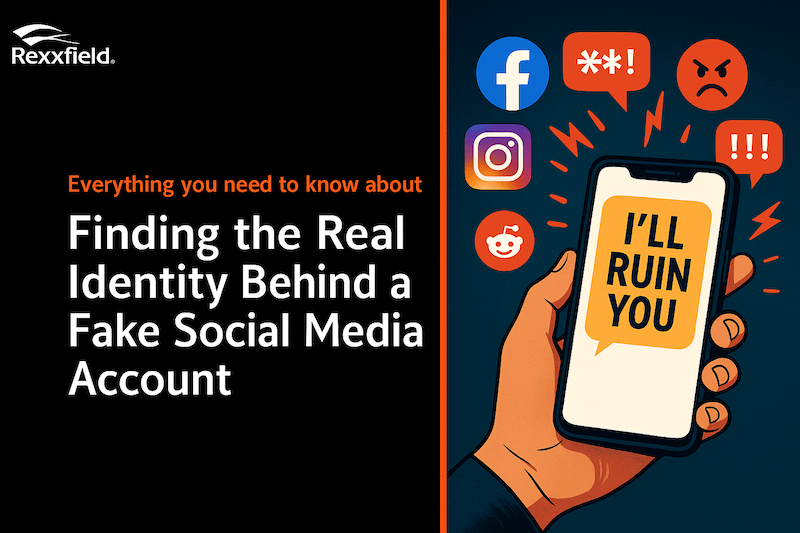Harassment through fake social media accounts has become a serious issue. People use false identities to target others with threats, lies, impersonation, and emotional manipulation. Whether it’s happening through Facebook, Instagram, Reddit, X, or TikTok, the goal is usually the same: hide behind a fake name while maliciously targeting someone for harassment or scam purposes. In most harassment cases we see, they appear out of nowhere, post just enough to stir the pot, and disappear just as quickly.
But even the most cautious of antagonists hiding behind a fake social media account leave traces. We share tips on finding the real identity behind a fake social media account yourself, and what other options you have if you need help.
How to Find the Real Person Behind Fake Social Media Accounts Yourself
If you want to find the real person hiding behind a fake profile, there are some things you can try yourself. These might not reveal the full identity, but may expose red flags, recycled details, uncover other related accounts, or lead to a suspect.
Reverse image search
Fake profiles often use fake AI generated, or stolen photos. Upload the profile picture of the profile to Google Images or TinEye to see where else it shows up on the internet. If you see other profiles, or websites, with the same photo, you are probably looking at a fake profile. Here is how to run a reverse image search on Google.
Search handle or username
People often reuse usernames on other platforms, so run a username search on Google, Twitter, Reddit, LinkedIn, or any other social sites. Most people reuse usernames across platforms. You might find other accounts with the same username, which may reveal connections to the real identity.
Analyze Linguistics
Research the language and behavior of the user. Does the user use phrases that suggest a specific region or age group? Do they post at the same time every day? Have they mentioned a school, job, or city without thinking? Even a small detail can give away more than they intended.
Look at their social circle
See who follows them and who they follow. Real accounts have connections with other real people. Fake ones tend to follow public figures or random users without any real interaction. Check if their followers look real or if they’re just other suspicious profiles with no content. Also check the comments on their posts.
Use free online tools
Sites like Social Catfish and Spokeo can help you look up usernames, photos, emails, or phone numbers.
If you are in the United States, IC3 is useful if you think the person might be part of a known scam or impersonation attempt. In Australia, the equivalent is Scamwatch.
These tools don’t always give you everything, but they can be very useful at pointing you to a direction. Especially if you already have a suspect, you may find connections that confirm those suspicions.
But they likely won’t unveil the real identity of the person hiding behind the fake account. Especially if the profiles uses original photos, usernames, and avoid personal comments. That’s when you might need the help of cyber investigators.
Find Cyber Investigators to Help Identify Behind Fake Social Media Accounts
At Rexxfield, our team specializes in identifying individuals behind anonymous profiles by using a combination of open-source intelligence (OSINT) and proprietary forensic tools. One of the key strategies we deploy is social engineering, but not in the casual sense of studying online behavior. We use legally compliant social deception methods to gather digital fingerprints from the anonymous user. Our methods are designed to reveal information without the target realizing we are doing so. We interact in a way to prompt the target into exposing technical data, like their IP address, location-based signals, or device handles, without letting them know that they are under investigation.
This is important to do in secrecy because it gives you a head start if you decide to take legal action: the antagonist will have no idea you are coming after them, so they won’t have time to cover their tracks.
From a technical standpoint, we rely heavily on tracking digital fingerprints, which are far more than browsing patterns or writing style.
Tracking the Digital Fingerprints of Social Media Account User
Everyone who uses a fake account on the internet leaves unique data. These digital fingerprints can’t easily be faked or erased. We track:
- IP addresses: these show which network someone used and where they were located at the time.
- This may lead to a suspect, who we can then rule in or out, without the need for subpoenas.
- If there is no suspect, a subpoena to the internet service provider can often reveal the identity of the anonymous user.
- User agent strings: these reveal what device and browser were used
- Hardware details: think graphics card ID, keyboard setup, or audio system configuration to help confirm if multiple profiles come from the same machine
- Language settings, cookie behavior, and even time of activity can also offer strong clues
These data points are not always visible to the public, but through controlled interaction, we’re able to collect them legally and document them fully.
Preparing for Legal Action
Many of our clients want to take legal action. You may want this too. In this case, you need hard evidence to prove in court who is responsible. That’s where we come in.
We don’t just collect information. We prepare the evidence in a way that can be presented in court and meets legal evidentiary standards. We also assist with affidavits, attorney coordination, and courtroom preparation if the case goes that far. Everything is logged and ready to support the legal process from beginning to end. We can assist with affidavits, coordinate with attorneys, and provide expert testimony when needed.
If you need our help, or would like a consultation (obligation-free), contact our investigators:
Case study – Investigating Fake Instagram and TikTok Account

Her father had already spoken with the New York State Police but wanted help identifying the person who had done this. He came to us looking for answers.
Our goal was simple. We needed to figure out who this guy really was so that the family could take the next step and so the abuse would stop.
We used her Instagram account to re-establish contact with the sextortionist and, with permission, also used the profile of one of her close friends. That allowed us to engage directly and begin gathering technical data without raising suspicion. The person on the other end was cautious and used a VPN to hide his tracks, but he still left behind enough digital fingerprints for us to work with.
Through social interaction and our own tools, we managed to collect key details like his IP address, what kind of device he was using, and other identifying data points. Once we had that, we ghostwrote a subpoena for the family and law enforcement. That allowed them to request subscriber information from the service provider tied to the IP address.
Even though the person behind the fake account had taken steps to stay anonymous, it wasn’t enough. He left just enough behind for us to trace. That gave the family what they needed to move forward and start reclaiming some peace after a horrible experience.
What You Can Do Now
If you’re dealing with someone who’s hiding behind a fake account and trying to make your life miserable, don’t wait for them to stop. Start with the simple steps. Try the free tools. Look for inconsistencies. If it’s more serious or if nothing you try works, let us help.
These accounts may seem untouchable, but they’re not. Everyone leaves a trace. You just need to know how to follow it.

